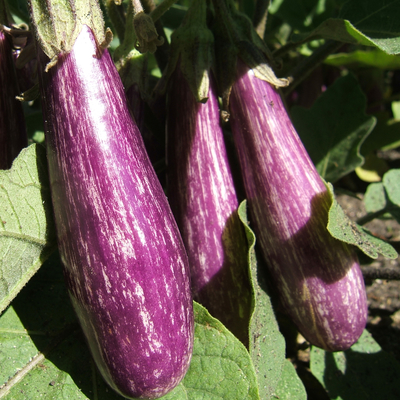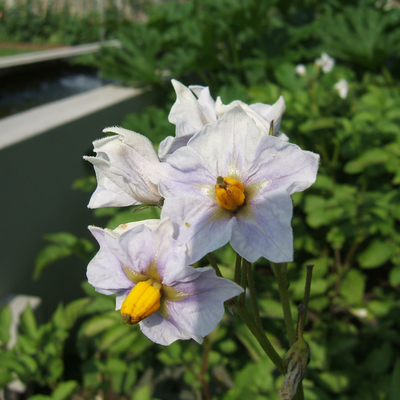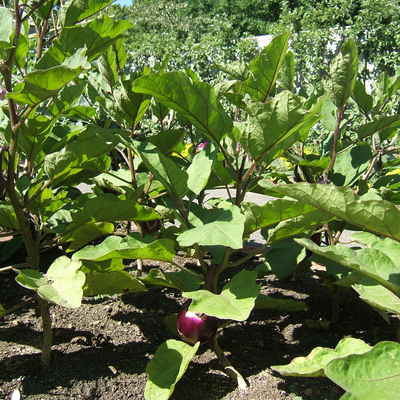Quick facts
- Eggplant needs warm weather and will not thrive during a cool season.
- When buying plants, choose sturdy plants up to a foot tall.
- Start eggplant seeds about eight weeks before planting them outside.
- Transplant outdoors after nighttime low temperatures are above 50°F.
- Install plant supports at the time of planting.
- Use mulch to heat the soil and reduce root damage.
- Harvest eggplants when they have reached mature size; clip them off with sharp shears.
Eggplant is a short season vegetable
Eggplant (Solanum melongena) is a relative of peppers, potatoes, tomatoes and tobacco.
Eggplant needs warm conditions, and will not thrive during a cool season. There are varieties available that thrive in Minnesota’s short summer season.
Soil pH and fertility
- Have your soil tested.
- A soil pH between 5.5 and 7.5 is best.
- Apply phosphorus (P) and potassium (K) should be applied according to soil test recommendations.
- Many Minnesota soils have enough phosphorus.
- Unless your soil test report specifically recommends additional phosphorus, use a low- or no-phosphorus fertilizer.
- Improve your soil by adding well-rotted manure or compost in spring or fall.
- Too much nitrogen fertilization will lead to plants that are bushy, leafy and slow to bear fruit.
- Do not use any fertilizer containing a weed killer ("Weed and Feed"), as it may kill your vegetable plants.
- Eggplants benefit from black plastic mulch because it helps to heat the soil and reduces root damage. Do not apply mulch before the soil has warmed in the spring.
Buying plants
If you buy plants from a garden center, choose sturdy plants up to a foot tall. They should have stems at least the width of a pencil and the leaves should be closely spaced up the stem. Do not buy plants with spots on their leaves, as you could be bringing disease into your garden.
If you buy plants from a mail-order catalog, you may need to keep them indoors until it is time to set them out. Treat them as if you had started them yourself.
Planting
Start eggplant seeds about eight weeks before planting outside.
- Plant seeds one-fourth inch deep, in flats containing sterile, soilless germination mix.
- Use a heating mat to keep the flat at 75°F to 85°F until seedlings emerge. Carefully monitor potting mix moisture, as heating mats will dry the mix out faster.
- A soil temperature of 70°F is best. Warm soil is better than cool.
- Provide bright overhead light for the seedlings.
- Thin or transplant seedlings after true leaves appear so that seedlings are two to three inches apart, and grow under bright light. Without enough bright light directly overhead, the stems of the little plants will lean over.
- Eggplants may start to flower while still indoors. Pinch off the flower clusters until the plants are in the garden.
- When plants are about five inches tall and eight to 10 weeks old, reduce watering.
- Place plants outside where they will receive wind protection and a couple hours of sunlight.
- Gradually expose them to more sunlight over the next week or two, bringing them indoors if night temperatures drop below 55°F.
White eggplant flowers
Location
- Choose a location in your garden where you have not grown tomatoes, potatoes, peppers, eggplants and tomatillos for the past three or four years. Practice crop rotation.
- Space eggplants 18 inches apart, in rows 30 to 36 inches apart.
Climate
- Although they are related, eggplants are much less cold hardy than tomatoes. If you plant your eggplants out before overnight low temperatures are consistently above 50°F, they will suffer from the chill. They may never recover and bear fruit.
- Check out this map for average frost-free dates in Minnesota.
- Transplant in late afternoon or on a cloudy, calm day.
- Drought temperatures above 90°F, and night temperatures below 60°F or above 70°F, can cause poor flowering.
- Fruit are also vulnerable to sunburn, and develop white patches if there is not enough leaf surface to cover fruit and protect them from sunlight exposure during hot, dry weather.
Treatment
- Water plants well before transplanting.
- Cut the soil between the plants with a knife so each plant can separate easily with the root ball attached.
- Transplant seedlings grown in separate containers without disturbing the roots.
- When transplanting seedlings in peat pots, do not expose the top edge of the peat pot above the soil surface, or the peat pot will act like a wick and rapidly draw the moisture from the root ball, stressing the plant.
- Set eggplant seedlings out in the garden so that the shoots are at the soil line as they were before transplanting.
- Scrape the dry surface soil from the planting area.
- With a hand shovel, make a hole large enough to receive easily the root ball of the transplant.
- Firm the soil around the roots and water the transplant.
- Install plant supports at the time of planting.
How to keep your eggplants healthy and productive
- Consistent soil moisture levels produce the best quality fruit. When soil moisture levels are inconsistent, eggplant can become bitter and yields will be low.
- Poor moisture levels can also cause blossom-end rot.
- Avoid overhead sprinkling. Wet leaves are more disease prone, and soil splashed up onto the leaves can contain disease spores.
- Light watering can promote shallow root development, increase the crop's vulnerability to hot weather and drought stress, and reduce fruit quality.
- If the plant does not receive one inch of rain weekly, soak the soil thoroughly at least once a week.
- Very sandy soils may require watering more often.
- Too fast a rate of irrigation will run off heavier soils without moisture sinking in.
- Frequent, shallow cultivation with a garden hoe or trowel will kill weeds before they become a problem. Cultivate just deeply enough to cut the weeds off below the surface of the soil.
- Mulch with herbicide-free grass clippings, weed-free straw, or other organic material to a depth of 3 to 4 inches to help prevent weed growth, decreasing the need for frequent cultivation.
- Harvest the eggplants when they have reached mature size, clipping them off with sharp shears.
- Do not try to pull the fruit from the plant. You are likely to damage both the fruit and the plant.
- As you continue to harvest, the plant will continue to produce flowers and set more fruit.
- Do not let the eggplants hang on the plant once they are mature, because their quality will decline. Pick when the skins are still shiny and the fruit is firm.
- Later in the season, cold nights will injure fruit left on the plant. Cover the plants if there are low temperatures in the forecast.
- Eggplants will keep for about a week in the refrigerator. They are sensitive to the cold, and their skins may become pitted after too long under refrigeration.
- Although you may blanch and freeze sliced eggplant, most gardeners do not consider this method good for preservation.
- There are some recipes for eggplant relish and pickled eggplant. Note that home-canned plain eggplant has previously been the source of Botulism poisoning.
Managing pests, diseases, and disorders
Many things can affect eggplant leaves, flowers and fruit. Changes in physical appearance and plant health can be caused by the environment, plant diseases, insects and wildlife. In order to address what you’re seeing, it is important to make a correct diagnosis.
You can find additional help identifying common pest problems by using the online diagnostic tools or by sending a sample to the UMN Plant Disease Diagnostic Clinic. You can use Ask a Master Gardener to share pictures and get advice.
- Cutworms chew stems at the soil line, giving plants a snipped appearance.
- Flea beetles chew many small, round holes into eggplant leaves. This can weaken plants and hurt fruit growth.
- Colorado potato beetles can destroy eggplants, as they can gather in large numbers and eat leaves.
- During periods of hot, dry weather, spider mites can feed on leaves, giving them a bleached or bronzed appearance.
Many plant diseases can be prevented using cultural practices, such as adequate plant spacing, pruning, rotation, and watering at the base of the plant.
- Verticillium wilt is the most common eggplant disease. It is soilborne and causes the leaves to turn yellow and curl inward. As the disease progresses, leaves dry out and turn brown.
- Early blight can infect eggplant, although this is not common.
Reviewed in 2023




